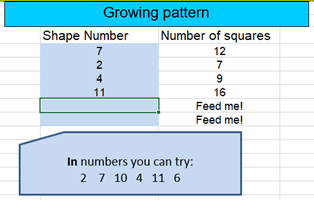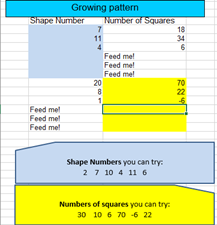Purpose
The purpose of this activity is to support students in expressing general (function) rules using algebraic notation. Students rely on using tables of values.
Achievement Objectives
NA4-9: Use graphs, tables, and rules to describe linear relationships found in number and spatial patterns.
Required Resource Materials
Activity
- Show students Sheet 1 of Spreadsheet 1 (Rule 1).
In this sheet we don’t see the original shape pattern, just the numbers that come from the pattern.
The blue box gives numbers that can be entered as the Shape Number. This is deliberate to avoid students entering a sequential set of numbers. The computer automatically generates the number of squares. Let students choose the numbers to go in the ‘Shape Number” column.
- Discuss the results of the numbers chosen by students.
Can you figure out what rule the computer is using?
Students should notice the rule is “add five.” Scroll across to column AA and click on a “Feed Me” cell to see the formula “=A11+5”.
In algebra we write that expression as n + 5 for the nth term.
- Work through the other sheets in Spreadsheet 1. Whilst the rules become increasingly complex, they are all linear. Students should enter the shape numbers, before trying to establish the rule, and then scrolling across to column AA to find the answer.
Encourage the students to express the rules using algebraic notation. You might introduce relevant te reo Māori kupu during this work, such as pānga rārangi (linear relationship) and kīanga taurangi (algebraic expression).
- Rule 2: 3n
- Rule 3: 2n+ 4
- Rule 4: 5n- 2
- Provide the students with Spreadsheet 2 to work on individually or in pairs. You might organise these pairs to encourage tuakana-teina. In this spreadsheet, column AA is hidden so students cannot scroll across to read the answer.
- Rule 1: 4n + 2
- Rule 2: 3n - 5
- Rule 3: 6n - 3
- Rule 4: 11n - 2
- Rule 5: 7n + 1
- Discuss strategies that were effective in finding the rules. Look for ideas such as:
- “The number of squares went up a lot, so I knew that I needed to choose a multiplier more than two.”
- “I always put in two consecutive numbers first and saw what the gain in the number of squares was. I used the gain as my multiplier.”
- “If 1 was available I used that first. That gave me a promising idea about how big the multiplier was.”
- Discuss the symbols used in the spreadsheet, in comparison to the algebraic symbols. For example, in the spreadsheet A4 refers to a specific number but the rest of the formula gives the function. “=A4*5-2” can be written as 5n – 2 in algebra.
Next steps
- Provide rules in which the multiplier is a negative integer, such as -2n + 6.
- Use Spreadsheet 3. This requires students to work backwards as well as forwards with the linear rules they find. Students must find the rule that changes the Shape Number into the Number of Squares, before reversing the process to find out what rule changes the Number of Squares into the Shape Number. The formulae are found in column AA.

Attachments
Add to plan
Level Four